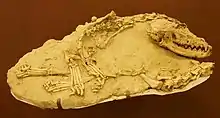| Eucyon Temporal range: Late Miocene–Late Pliocene, | |
|---|---|
 | |
| Fossil skeleton of Eucyon davisi | |
| Scientific classification | |
| Domain: | Eukaryota |
| Kingdom: | Animalia |
| Phylum: | Chordata |
| Class: | Mammalia |
| Order: | Carnivora |
| Family: | Canidae |
| Subfamily: | Caninae |
| Genus: | †Eucyon Tedford and Qiu (1996)[1] |
Eucyon (Greek: εὖ eu: good, true; κῠ́ων cyon: dog) is an extinct genus of medium omnivorous coyote-like canid that first appeared in the Western United States during the late Middle Miocene 10 million years ago. It was the size of a jackal and weighed around 15kg. Its species E. zhoui was one of a number of North American mammals which invaded East Asia around 5–6 million years ago, followed by the genus going extinct 3 million years ago. This genus is proposed to have given rise to genus Canis 6 million years ago.[2]: p56–58
Taxonomy
Eucyon was named by Tedford and Qiu in 1996.[1] Phyletically it stood between Canis and the South American canines that would follow it.[2]: p56 In 2009, Tedford revised its diagnosis and described two of its species, E. skinneri and E. davisi,[3]: 89 which was originally named Canis davisi by Merriam in 1911.[4][3]: 89
Eucyon davisi
The jackal-sized Eucyon existed in North America from 10 million YBP until the Early Pliocene.[5] Wang and Tedford proposed that the genus Canis was the descendant of the coyote-like Eucyon davisi, remains of which first appeared in the Miocene (6 million YBP) in the southwestern U.S. and Mexico. By the Pliocene (5 million YBP), the larger Canis lepophagus appeared in the same region and by the Early Pleistocene (1 million YBP) Canis latrans (the coyote) was in existence. They proposed that the progression from Eucyon davisi to C. lepophagus to the coyote was linear evolution.[2]: p58
Description
A medium canid the size of a jackal and weighing around 15 kg (33 lb).[2]: p56
Fossil distribution
The fossil remains are found in the Rio Grande, Texas to western Oregon and Washington's Ringold Formation,[6] as well as northern Nebraska, along with Greece, Ethiopia, Mongolia and many other locations across the Old World.[7]
References
- 1 2 R. H. Tedford and Z. Qiu. 1996. A new canid genus from the Pliocene of Yushe, Shanxi Province. Vertebrata PalAsiatica (Gujizhui Dongwu Xuebao) 34(#1):27-40
- 1 2 3 4 Wang, Xiaoming; Tedford, Richard H. (2008). Dogs: Their Fossil Relatives and Evolutionary History. Columbia University Press, New York. pp. 1–232. ISBN 978-0-231-13529-0.
- 1 2 Tedford, Richard H.; Wang, Xiaoming; Taylor, Beryl E. (2009). "Phylogenetic Systematics of the North American Fossil Caninae (Carnivora: Canidae)" (PDF). Bulletin of the American Museum of Natural History. 325: 1–218. doi:10.1206/574.1. S2CID 83594819.
- ↑ Merriam, J.C. 1911. Tertiary mammal beds of Virgin Valley and Thousand Creek in northwestern Nevada. Part 2. Vertebrate faunas. Bulletin of the Department of Geology of the University of California 11: 199–304.
- ↑ Fossilworks website Eucyon davisi
- ↑ Gustafson, Eric Paul (2015). "An Early Pliocene North American Deer: Bretzia pseudalces, Its Osteology, Biology, and Place in Cervid History". S2CID 83622137.
{{cite journal}}: Cite journal requires|journal=(help) - ↑ Rook, Lorenzo (December 2009). "The wide ranging genus Eucyon Tedford & Qiu, 1996 (Mammalia, Carnivora, Canidae, Canini) in the Mio-Pliocene of the Old World". Geodiversitas. 31 (4): 723–741. doi:10.5252/g2009n4a723. S2CID 130345058.